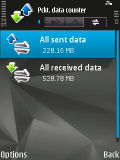
Recently I took the train from Linz to Vienna and I was quite surprised that Mobilkom Austria (A1) must have put a more or less dedicated 3G coverage alongside the railway track even in very rural areas. I've had 3G coverage for most parts of the trip and in the few places 3G coverage was lost, their EDGE network kicked in. I've reported on my experiences with non-optimized 3G HSDPA coverage on board of trains before (here and here), but this time, the experience was even better. The connection I established was maintained throughout the trip and high speed data transfers taking several minutes were performing very well as shown on the image on the left. I even dared to launch my IM client as connectivity was simply always there. I stepped out of the train very impressed by what is possible when operators decide to do a proper network planing and deployment.
Category: Travel
Uplink Downlink Ratios Revisited

I've been traveling for two weeks now in Austria and Italy and have been online throughout that time 'only' via 3G to do my daily business thanks to prepaid 3G Internet access. Wherever I went, 3G HSPA access has been available so using the Internet with a 2 MBit/s downlink on average didn't feel much different from using DSL at home. I've reset the data counters on my N95, which I used as my 3G modem during the trip, to get an idea on how much data I exchanged. In the past seven days, I used about 750 MB in total for e-mail, web browsing, company Intranet access, VoIP, IM, etc.
As can be seen on the picture on the left, my uplink to downlink ratio is around 1:2 and not 1:10 as I observed during a previous trip. That's probably got something to do with the fact that this time, I received and sent many e-mails with massive file attachments (those 5 MB PDF or PPT files everybody likes…) and have been using VoIP extensively for lengthy conference calls. With VoIP, the uplink / downlink ratio is 1:1 and generates around 20 MB per hour in each direction.
From a network point of view a 1:2 ratio means that I used about as much resources in the uplink as I did in downlink, since uplink transmissions are less efficient than those in downlink due to the smaller antenna and little transmission power compared to a base station. While in most situations, I could get uplink speeds of around 400 kbit/s, which is almost as fast as the uplink of my DSL line at home, I nevertheless wished I would have had a High-Speed Uplink Packet Access (HSUPA) capable device and network. Those 5 MB Power Point presentations do take quite a while to get transmitted.
Yes, one can never have enough bandwidth 🙂